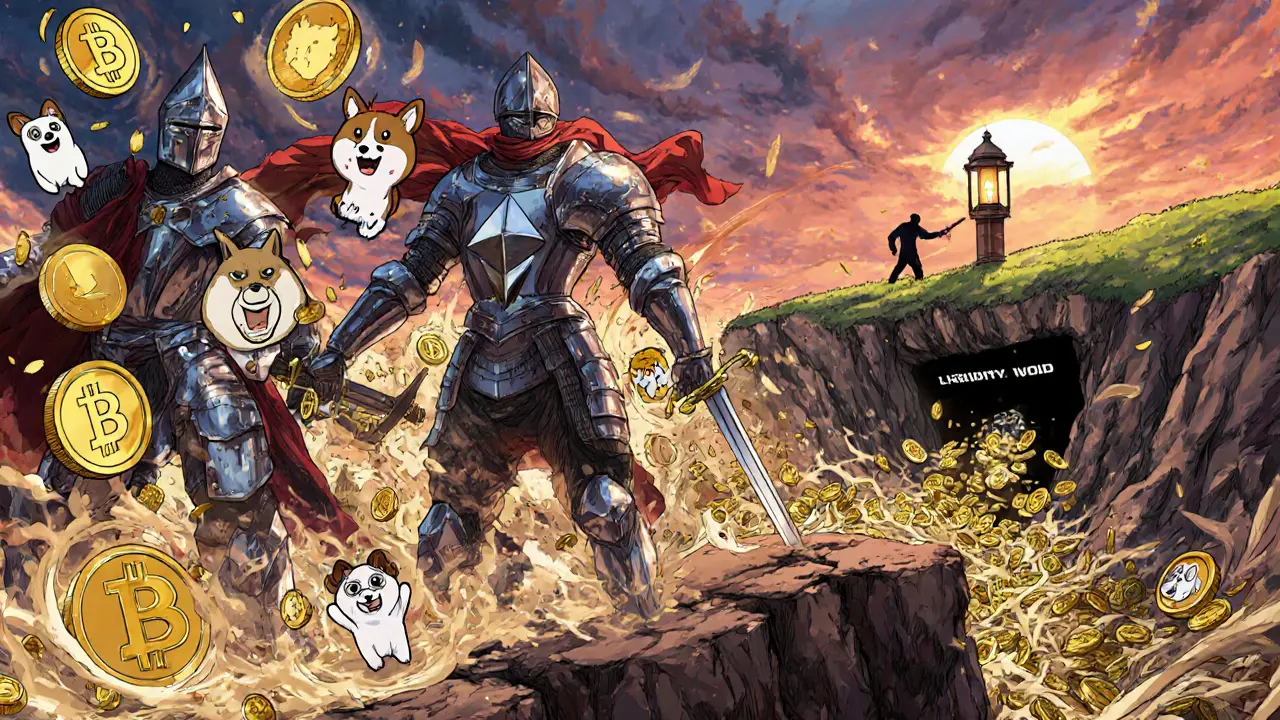Crypto Leverage Risk Calculator
Understanding Your Risk
Based on the 2025 liquidity crisis where Bitcoin dropped 22.5% and $2.23 billion in positions were liquidated, this calculator shows how leverage magnifies your losses during market downturns.
Input Your Trade Details
Important: The article explains that leverage amplifies both gains and losses. In the 2025 crisis, 10x leveraged positions were wiped out when Ethereum dropped 9.5%.
By April 2025, the crypto market had lost over half its value in just three months. What started as a quiet pullback turned into a full-blown liquidity crisis-a moment when nobody could buy or sell without dragging prices down further. This wasn’t just another correction. It was the system screaming under pressure. Bitcoin, which hit $100,000 in January, crashed to $77,500. Ethereum broke below $4,000. Solana lost more than half its value. And behind the numbers, thousands of retail traders got wiped out-not because they made bad bets, but because the market simply ran out of buyers.
How a Government Account Triggered a Crypto Meltdown
It didn’t start with a hack or a scam. It started with the U.S. Treasury. In early 2025, the Treasury General Account (TGA) began refilling its coffers by pulling $500-600 billion out of the broader financial system. That money didn’t vanish-it got moved from banks and investment funds into U.S. government bonds. But for risk assets like crypto, it was like pulling the plug. When institutional money pulls back, crypto feels it first. Why? Because crypto has no safety net. There are no central banks stepping in to print money. No Wall Street firms holding massive reserves to stabilize prices. Just algorithms, retail traders, and leveraged positions hanging by a thread.The Feedback Loop That Turned a Drop Into a Free Fall
When Bitcoin started falling, automated trading bots kicked in. These bots are programmed to sell when prices drop past certain levels-especially if traders are using leverage. A 5% drop? Sell. A 10% drop? Liquidate. By the time the dust settled, $2.23 billion in long positions had been forcibly closed. $1.88 billion of that was from traders who thought the rally would keep going. They weren’t wrong-until they were. The problem? Crypto markets are thin. There aren’t enough buyers to absorb the selling. So every time someone got liquidated, prices dropped further, triggering more liquidations. It became a death spiral.Ben Kurland from DYOR put it simply: “In crypto, conviction is high but liquidity is thin-which is why moves down feel like free falls, while recoveries grind back more slowly.” That’s the core issue. People believe in crypto. They’re willing to bet big. But when the market turns, there’s no deep pool of cash waiting to buy the dip. The buyers disappeared.
Why DeFi Couldn’t Save the Day
You’d think decentralized finance would help. After all, DeFi protocols like Uniswap and Aave are supposed to provide liquidity without middlemen. But here’s the catch: most DeFi liquidity is circular. It doesn’t come from outside the system-it comes from other crypto users lending, staking, or trading within the same ecosystem. When Bitcoin and Ethereum dropped, the whole loop broke. People pulled their money out of lending pools. Liquidity providers panicked and withdrew. Trading volumes on decentralized exchanges plunged. Arthur Breitman, co-founder of Tezos, called it the “circular economy problem.” Crypto was built on a house of cards made of other crypto. When one card fell, the whole stack started collapsing.
Altcoins Got Crushed-And Memecoins Vanished
Bitcoin and Ethereum held up better than most. The real bloodbath was in altcoins. Solana, which had surged past $300 in January, crashed to under $140. Solana-based tokens lost even more. Projects that relied on hype, not fundamentals, evaporated. Memecoins like Dogecoin, Shiba Inu, and newer tokens tied to viral trends lost 70-90% of their value. These weren’t just speculative bets-they were liquidity drains. Traders who had money stuck in these coins had to sell something else to cover losses. That meant selling Bitcoin, Ethereum, or even stablecoins. The panic spread like a virus.Regulatory Uncertainty Made Things Worse
In late 2024, many thought Donald Trump’s election would mean crypto-friendly policies. Promises of a national Bitcoin reserve and a dedicated crypto council got traders excited. But by February 2025, nothing concrete had happened. The administration stalled. Meanwhile, new tariffs on imports from Mexico, Canada, and China sent shockwaves through global markets. Inflation ticked up again. Investors started asking: “If the economy is shaky, why are we still betting on crypto?” Regulatory fear isn’t about new laws-it’s about the absence of clarity. When you don’t know if your assets will be banned tomorrow, you sell. And you sell fast.What the Numbers Don’t Show: The Human Cost
Behind every percentage drop is a person. Reddit threads filled with messages like “I lost my rent money,” “I can’t pay my student loan,” “I thought this was my ticket out.” Many had borrowed money to trade crypto-using credit cards, margin loans, or peer-to-peer platforms. When liquidations hit, they didn’t just lose their investment-they lost their financial stability. One trader from Toronto posted: “I opened a 10x leveraged position on ETH at $4,200. When it dropped to $3,800, my position was wiped. I didn’t even get a warning.” That’s the reality of crypto leverage. It’s not a tool-it’s a trap for the unprepared.
Why This Crisis Is Different From 2022
Back in 2022, FTX collapsed. That was a single point of failure. This time, the whole system cracked. No one exchange failed. No one project went bankrupt overnight. But thousands of positions did. The problem wasn’t fraud-it was structure. Crypto markets are built for boom times. They’re not built to survive busts. In traditional markets, banks and market makers provide liquidity even when everyone’s scared. In crypto? There’s no one holding the bag. Just algorithms and scared individuals.What’s Happening Now? (October 2025 Update)
As of October 2025, the market is stabilizing-but not recovering. Bitcoin is trading around $82,000. Ethereum is holding near $3,900. But trading volumes are still 40% below their January highs. Institutional investors are watching. Some are quietly buying. Others are waiting. Exchanges like Coinbase and Binance are under pressure to improve liquidity safeguards. Regulators in the U.S., EU, and Singapore are starting to talk about mandatory liquidity reserves for major exchanges. It’s too early to say if these changes will help. But one thing is clear: the era of “just buy and hope” is over.What You Need to Do Now
If you’re still in the market, here’s what matters:- Drop the leverage. 5x, 10x, 20x-none of it matters if the market drops 15%. You’ll get liquidated before you can blink.
- Hold only what you can afford to lose. Crypto isn’t a savings account. It’s a high-risk bet. Treat it like one.
- Watch the 200-day moving average. When Bitcoin drops below it, liquidity dries up. That’s your signal to pause, not panic.
- Avoid memecoins and low-cap altcoins. They’re the first to die in a crisis. They’re not investments-they’re gambling chips.
- Keep cash outside crypto. Stablecoins are fine for short-term use. But real cash in a bank? That’s your safety net.
The crypto market will recover. It always does. But the next bull run won’t look like the last one. The players are different. The rules are changing. And if you don’t adapt, you won’t survive it.
What caused the 2025 crypto liquidity crisis?
The 2025 crypto liquidity crisis was triggered by the U.S. Treasury pulling $500-600 billion out of the financial system to refill its TGA account. This drained liquidity from risk assets like crypto. Combined with rising inflation, new tariffs, and delayed regulatory signals, investor confidence collapsed. Automated trading bots and leveraged positions amplified the sell-off, leading to $2.23 billion in forced liquidations.
Why did Bitcoin and Ethereum drop so hard?
Bitcoin dropped from $100,000 to $77,500 because it lost its role as the market’s anchor. When altcoins and memecoins crashed, traders sold Bitcoin to cover losses elsewhere. Ethereum fell below $4,000 because it was the most heavily traded altcoin with high leverage. Its price break triggered cascading liquidations across DeFi and centralized exchanges.
How did DeFi contribute to the crisis?
DeFi protocols rely on circular liquidity-funds lent, staked, or traded within the crypto ecosystem. When prices fell, users pulled money out of lending pools and liquidity pools to cover losses. This caused trading volumes to collapse, making it harder to buy or sell without moving prices. DeFi didn’t fail-it just had no external source of liquidity to fall back on.
Are crypto markets more volatile than traditional ones?
Yes. Traditional markets have institutional market makers who step in during crashes to provide liquidity. Crypto doesn’t. It relies on retail traders and algorithms, which amplify selling pressure. When one position gets liquidated, it triggers others. That’s why crypto drops feel like free falls-there’s no one holding the bottom.
Should I avoid crypto altogether after this crisis?
No-but you need to change how you play. Crypto isn’t going away. But the days of quick riches through leverage and memecoins are over. If you want to participate, focus on long-term holding, avoid leverage, keep cash reserves, and only invest what you can afford to lose. The market is maturing. So should you.
What’s the biggest lesson from the 2025 crisis?
The biggest lesson is that crypto markets are still fragile. They can’t handle external shocks without collapsing. Until exchanges, DeFi protocols, and regulators build real liquidity buffers, crypto will keep crashing when the world gets nervous. Resilience-not hype-is the new priority.







Comments
Ryan McCarthy
November 10, 2025 AT 16:10 PMMan, this hit different. I watched my portfolio get gutted in April and honestly? I didn’t even cry. Just stared at the screen like a zombie. Crypto’s not a get-rich-quick scheme anymore-it’s a marathon with landmines. I’m holding BTC and ETH now, zero leverage, and I sleep better. No more chasing pumps. Just staying alive.
Hope Aubrey
November 11, 2025 AT 16:15 PMUgh. I told everyone this was gonna happen. The TGA move was a silent killer. People think crypto’s decentralized? Nah. It’s just as dependent on Fed policy as Wall Street-just without the safety nets. And don’t even get me started on those ‘degen’ meme traders who blew up their credit cards. They weren’t investors-they were gamblers with a crypto app open.
andrew seeby
November 13, 2025 AT 06:59 AMbro i just bought 0.002 btc at 82k 😭 i know i’m late but i believe… 🤞📈
Abelard Rocker
November 15, 2025 AT 00:15 AMOhhh this is just beautiful. The U.S. Treasury pulls cash from the system like it’s vacuuming dust from a rug while the rest of us are left holding a broken vacuum cleaner with a $200,000 debt on it. Crypto’s not dying-it’s being assassinated by bureaucracy wrapped in a 10-year-old PowerPoint deck titled ‘Fiscal Responsibility.’ And now we’re supposed to ‘adapt’? Adapt to what? A world where your life savings get liquidated by an algorithm because the Fed decided to refill its piggy bank? This isn’t finance-it’s performance art with a side of existential dread.
Tara R
November 15, 2025 AT 21:26 PMPeople who lost money in crypto never understood risk management. It’s not the market’s fault you used 10x leverage. You didn’t lose because of systemic failure-you lost because you were reckless. This is capitalism. No one owes you a bailout. Get a job. Stop gambling.